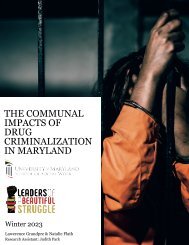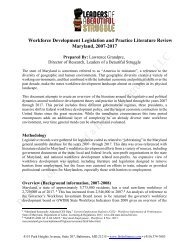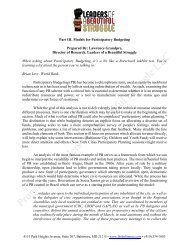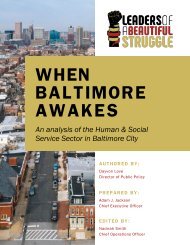Drug Decriminalization in Maryland Through an African Centered Research Paradigm- Analysis and Recommendations
This document offers guidance for theorizing questions related to a proposed research project purposed to advance drug decriminalization in Maryland.
This document offers guidance for theorizing questions related to a proposed research project purposed to advance drug decriminalization in Maryland.
- No tags were found...
You also want an ePaper? Increase the reach of your titles
YUMPU automatically turns print PDFs into web optimized ePapers that Google loves.
Introduction - Beyond the “St<strong>an</strong>dard Model” of the “Decrim<strong>in</strong>alize <strong>Drug</strong>s” Argument<br />
S<strong>in</strong>ce the 1930s, when Harry Ansl<strong>in</strong>ger led federal efforts to crim<strong>in</strong>alize drugs through the<br />
1937 Mariju<strong>an</strong>a Tax Act, <strong>an</strong>d then aggressively enforced prohibition under the Federal Bureau of<br />
Narcotics (the precursor to the DEA), drug prohibition enforcement has been a staple of Americ<strong>an</strong><br />
govern<strong>an</strong>ce (Hari, 2016). Federal policy trickled down to state policy, claim<strong>in</strong>g the harmful social<br />
<strong>an</strong>d public health impacts of drug use warr<strong>an</strong>ts <strong>an</strong> aggressive exp<strong>an</strong>sion of the “War on <strong>Drug</strong>s.”<br />
With the notable exception of a short period <strong>in</strong> the 1970s where c<strong>an</strong>nabis decrim<strong>in</strong>alization was<br />
pursued, state <strong>an</strong>d federal governments have cont<strong>in</strong>ued to enforce drug prohibition aggressively.<br />
(Alex<strong>an</strong>der, 2010). From its outset, with Ansl<strong>in</strong>ger conjur<strong>in</strong>g fears of Mexic<strong>an</strong> mariju<strong>an</strong>a<br />
<strong>in</strong>toxication, creat<strong>in</strong>g the threat of violence, <strong>an</strong>d target<strong>in</strong>g Black jazz musici<strong>an</strong>s with explicitly<br />
racialized justification, the War on <strong>Drug</strong>s has had disproportionate impacts on racial m<strong>in</strong>orities.<br />
Despite mak<strong>in</strong>g up approximately 30% of the nation's population, m<strong>in</strong>orities make up 80% of<br />
federal convictions on drug charges <strong>an</strong>d 60% of state <strong>an</strong>d local drug convictions (<strong>Drug</strong> Policy<br />
Alli<strong>an</strong>ce, 2016). Despite this hyper <strong>in</strong>carceration, rates of addiction <strong>an</strong>d drug crime have primarily<br />
rema<strong>in</strong>ed static despite the Americ<strong>an</strong> prison population explod<strong>in</strong>g by over 700% from 1970 to<br />
2010 (Flatow, 2014). The impacts on communities of color have been exp<strong>an</strong>sive, <strong>an</strong>d a full<br />
account<strong>in</strong>g of the harmful effects are beyond the scope of this project.<br />
With<strong>in</strong> the past 20 years, America's War on <strong>Drug</strong>s has faced a new development - the<br />
exp<strong>an</strong>sion of a widespread “opioid epidemic” - which has swept the nation. While created by a<br />
multitude of factors, the epidemic is largely seen as a confluence of economic malaise <strong>in</strong> broad<br />
swaths of the country, especially Appalachia <strong>an</strong>d the Southern United States; the massive<br />
exp<strong>an</strong>sion of prescribed opioid-based pa<strong>in</strong>killers such as Perdue Pharmaceuticals “oxycont<strong>in</strong>,” <strong>an</strong>d<br />
the availability of less expensive hero<strong>in</strong> from Mexico (Qu<strong>in</strong>ones, 2015). Unlike the coca<strong>in</strong>e<br />
epidemic of the 1980s, this opioid epidemic produced a massive <strong>in</strong>crease <strong>in</strong> overdose deaths,<br />
<strong>in</strong>clud<strong>in</strong>g <strong>in</strong> white communities, which largely avoided the worst impacts (both addiction <strong>an</strong>d<br />
police crackdowns) of the coca<strong>in</strong>e p<strong>an</strong>ics of the 1980s <strong>an</strong>d 1990s. Opioid overdose deaths have<br />
more th<strong>an</strong> quadrupled from 2000 to 2019 (National Institute on <strong>Drug</strong> Abuse, 2020). Visions of<br />
young men <strong>an</strong>d women wither<strong>in</strong>g away under the grip of opioid addiction shocked the nation,<br />
lead<strong>in</strong>g m<strong>an</strong>y to wonder what radical <strong>in</strong>terventions were needed to address this crisis.<br />
These historical realities create the environment for what one could call the “st<strong>an</strong>dard<br />
model” of drug decrim<strong>in</strong>alization. This model is <strong>an</strong> <strong>in</strong>tellectual <strong>in</strong>tervention to the ideological<br />
“common sense” power<strong>in</strong>g of the previously established narrative around the War on <strong>Drug</strong>s. In a<br />
nutshell, it might sound someth<strong>in</strong>g like the follow<strong>in</strong>g:<br />
4151 Park Heights Avenue, Suite 207, Baltimore, MD 21215 • www.lbsbaltimore.com • (410) 374-7683









